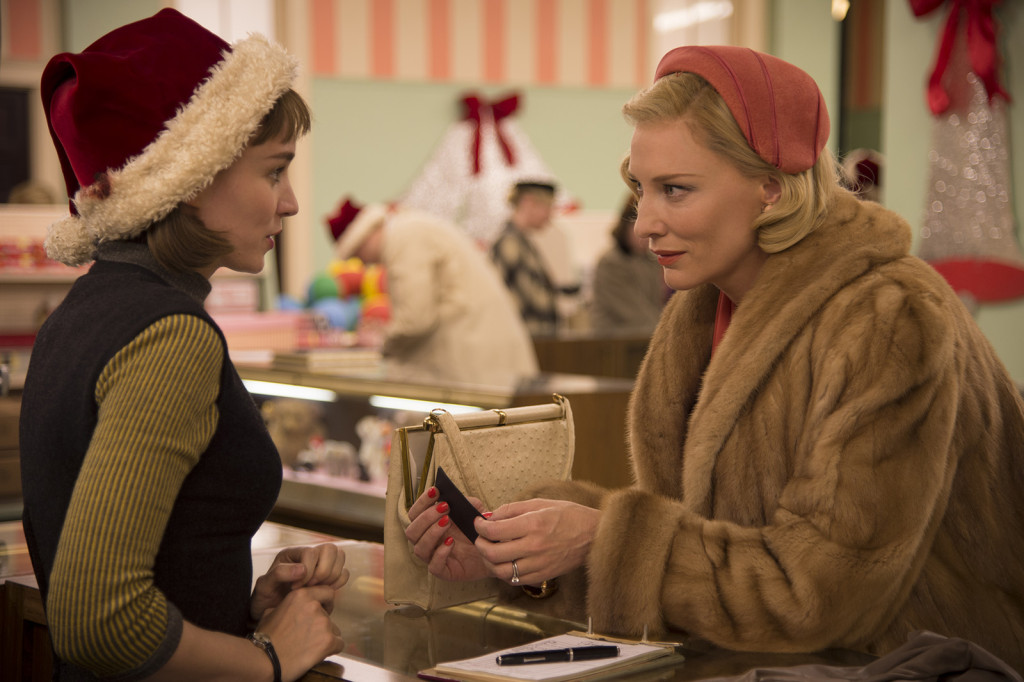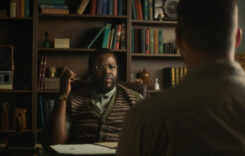DECEMBER 14, 2015
Todd Haynes’ new film “Carol” has had two very good weeks on the awards front.
On December 2, the film received four awards from the prestigious New York Film Critics Circle — Best Picture, Director, Screenplay and Cinematography. Last Wednesday, the film’s two stars received nominations from the Screen Actors Guild — Cate Blanchett (Best Actress) and Rooney Mara (Best Supporting Actress), and the next day “Carol” received more Golden Globe nominations than any 2015 film — Best Picture, Director, Score and two Best Actress nominations for Blanchett and Mara. (We’ll get to that category confusion for Mara in a second.)
So, needless to say, you’ll be hearing a lot about “Carol” over the next few months. But is all this awards hype deserved? Definitely yes, but to enjoy “Carol” fully, you should know what you’re getting into. Based on the 1952 novel “The Price of Salt” by acclaimed writer Patricia Highsmith (under the pseudonym Claire Morgan), “Carol” tells of a secret love affair between Carol, a posh New Jersey housewife (Blanchett), and Therese, a mousy New York department store clerk (Mara).
If you’re in the market for some hot girl-on-girl action, “Carol” is not that (for the most part). Nor is it a tragic romance like “Brokeback Mountain” (though it does deal with some of the same issues of repression explored in the Ang Lee film). “Carol” is something else, and it is one cool customer. Its costuming and sets are an impeccable recreation of 1952 life, but underneath that sheen, beats a fiery heart. It just takes a little work to find it.
“Carol” is set in the time where same-sex attraction could only be expressed in subtle signals — a nod here, a smile there, invisible to passers-by but one that spoke volumes if you knew how to listen. Take the first encounter between the two women in the toy department of a department store. Therese is behind the counter flanked by shelves filled with little girl dolls and notices a mink-clad Carol, sweeping in with all the bravado of a movie star. Carol also eyes Therese, who is dressed as one of Santa’s elves and asks her advice for a toy for her daughter. Therese convinces Carol to purchase a train set, and after the transaction is complete, Carol “accidentally” leaves her gloves on Therese’s counter, necessitating a follow-up contact. And the games begin.
In another masterful performance, Blanchett portrays Carol as a woman who will stop at nothing to follow her heart, no matter how reckless her actions may appear. Carol has recently ended an affair with Abby, a family friend (Sarah Paulson, excellent as always), and her lesbian liason has come to the attention of Carol’s confused and angry husband Harge (a powerful Kyle Chandler), who uses her affair as a weapon in the couple’s many arguments. Now her attraction to Therese could jeopardize her marriage even further.
For her part, Therese’s goal is to become a photographer, which is only appropriate given her role in this relationship as an observer. Just as she stands back watching life go by through a lens, Therese views relationships from a distance. On a visit to Carol’s home, she watches mother and daughter decorate the Christmas tree from two rooms away. She observes as Harge and Carol fight outside through the safety of a living room window. She slowly begins to recognize the emotional distance she brings in her bond with Carol has to be changed if their relationship ever has a chance of working.
A quick word on Rooney Mara. I have found her in the past to be a measured actress, whom I respected more than I loved. Here, though, she’s great, adding multiple layers as Therese slowly comes out of her shell, and the actress deserves every nomination coming her way. However, the film’s distributor, The Weinstein Company, is playing cute with the Oscar game, asking voters to consider her for Best Supporting Actress, which is an absolute joke. Mara is clearly a co-lead with Blanchett, which the Cannes Film Festival and the Golden Globes have already recognized. However, it seems that the SAG nominators fell for the Weinsteins’ ploy and nominated her in supporting, raising the very real possibility that her Oscar vote might be split, and she’ll miss out on a nomination completely, only because of Harvey Weinstein’s attempt at category fraud. Given the quality of Mara’s work, that would be a real shame.
Director Todd Haynes is no stranger the portrayal of forbidden love. In perhaps his most celebrated film, 2003’s “Far From Heaven,” Haynes depicted the unhappy life of another 1950s housewife who, while dealing with her marriage to a closeted businessman (Dennis Quaid), falls in love with an African-American gardener (Dennis Haysbert), in a love affair almost as forbidden at the time as the one depicted here.
“Carol” has been accused by some as being too chilly, unwilling to give the audience the same emotional oomph as its Oscar rivals “Spotlight” and “Brooklyn” (ironically, a very different take on a 1950s New York shopgirl). With no slight intended, I think I would use another word — “studied.” You sense that in every frame, Haynes and his screenwriter Phyllis Nagy calibrate just how much about the women’s relationship they want to reveal and just how much emotion that they want each scene to generate.
Take the film’s final scene (no spoilers). Haynes and Nagy knows what we the audience want. And they make us wait. And wait. And wait. And maybe, just maybe, they give it to us. Studied, but masterful.
GRADE: A-












